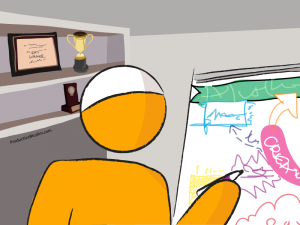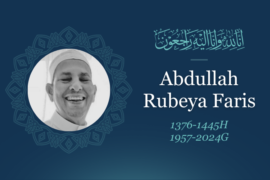 In the first part of this series, you will read about the background and the benefits of creative thinking as well as some tips about how you can start tapping into your creativity.
In the first part of this series, you will read about the background and the benefits of creative thinking as well as some tips about how you can start tapping into your creativity.
Your Creative Potential
Many people link creativity to art. It’s true that artistic expression is one form of creativity, but there’s so much more to creativity than painting, sculpture or writing poetry. We, humans have been given the gift of thinking and understanding, something which Allah  often mentions in the Qur’an.
often mentions in the Qur’an.
And your Lord inspired the bee, saying, ‘take your habitations in the mountains and in the trees, and in what they erect.’. Then eat of all fruits, and follow the ways of your Lord made easy, there comes forth from within their bellies a drink of varying color, wherein is healing for men. Verily in this is a sign for people who think” [Quran: Chapter 16, Verse 68-69]
“Thus Allah makes clear His Ayat to you, in order that you may understand” [Quran: Chapter 2, Verse 242]
Using this God-given gift of thinking in a creative way means to use our faculties and skills to come to something original and beneficial, whether it is a solution to a problem, an idea or theory, or a way of doing something. Everyone has the capacity to be creative, in one way or another. When we use our creative potential, we are open to new ideas and information and we try to see things from different perspectives.
Creative thinking benefits you in many ways. It boosts your problem solving skills and can help you to be more productive and build good habits. It gives self-confidence and, as it deepens your understanding of the world around you, it can also deepen your connection to the ultimate Creator.
Our Creative Legacy
The history of Islam is full of beautiful examples of creative thinking. In fact, great things have been achieved by means of people’s willingness to be creative and innovative and carve out new paths. Many of these Muslim pioneers still hold a very special place in our hearts. Think about Imam Malik. Think about Ibn Sina and Ibn al Haitham. And when we look at the seerah of our beloved Prophet Muhammad  we will find examples too. At one time, the Prophet
we will find examples too. At one time, the Prophet  came up with a very creative solution when he was called to mediate between the different tribe leaders who were rebuilding the Ka’aba and arguing about who should put the black stone in its place. He settled the matter by letting all four leaders hold a corner of the cloak on which he had placed the black stone. And then his readiness to accept Salman al Farsi’s suggestion to dig trenches when they were besieged by their enemies, a strategy unknown to the Arabs, also shows us our Prophet’s openness to new ideas and solutions.
came up with a very creative solution when he was called to mediate between the different tribe leaders who were rebuilding the Ka’aba and arguing about who should put the black stone in its place. He settled the matter by letting all four leaders hold a corner of the cloak on which he had placed the black stone. And then his readiness to accept Salman al Farsi’s suggestion to dig trenches when they were besieged by their enemies, a strategy unknown to the Arabs, also shows us our Prophet’s openness to new ideas and solutions.
Where to start: tips to get you on the road
Where can you start when you feel that your creative thinking skills are buried under thick layers of dust? Here are some simple steps to help you reconnect with your creative potential:
1. Be confident that you have the capacity to be creative. This is a very important first step. There are many people who think that creativity is something for geniuses or truly inspired people. Or that creativity isn’t something you can develop; you either have it or you don’t. Be confident in the fact that it’s a potential with which all human beings are blessed, including you.
2. Read about creative thinking and creative people. Knowledge often works; inspiring and reading about creative thinking may get you inspired and increase your confidence at the same time. Some experts who have authored multiple books about creative thinking are, for example, Edward de Bono, Michael Michalko, and Roger Von Oech. These books focus on how creativity works, what types of creativity there are, and how you can cultivate your skills to benefit you:
“Creative thinking is not a talent; it is a skill that can be learned. It empowers people by adding strength to their natural abilities which improves teamwork, productivity and, where appropriate, profits.” (Edward de Bono)
3. Mind mapping. A great technique to start with, because generating ideas and making associations are at the base of creative thinking. Mind mapping is a free-association technique that can be used for ideas, making a plan or solving a problem. You place an image, which represents the subject, in the middle of a piece of paper. Then draw thick branches flowing out from the picture for the main associations, smaller sub-branches for further associations, and so forth. Make it as visual as possible, using vivid colors and pictures. Don’t add more than one or two words per branch, because the more words you use for description, the more you limit your associations
4. Break your routine. Sometimes it can be helpful to change your routine to get a fresh perspective on things. Take a completely different route to work or college, for example. Buy your food at a different supermarket, or why not go to the market instead? Start your meal with the dessert, or browse a different section of the library. There are many opportunities to do some of your routines differently and let a fresh wind blow through your day.
In the second part of this series, we will talk about habits and thought patterns that block us from thinking creatively, and, of course, more practical tips to keep you going.
Do you have any creativity ideas or tips of your own? What helps you think ‘out of the box’?



